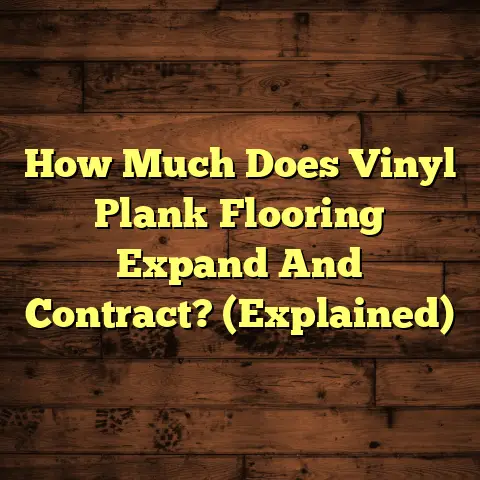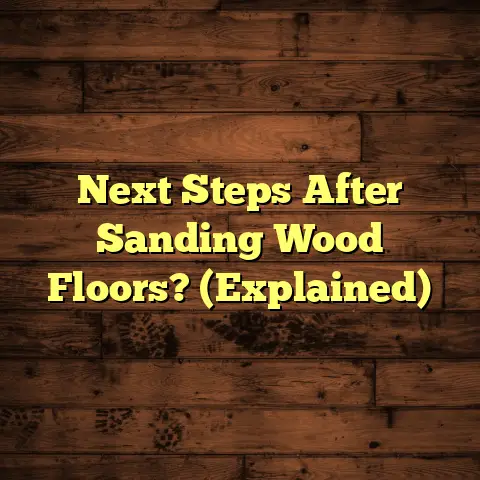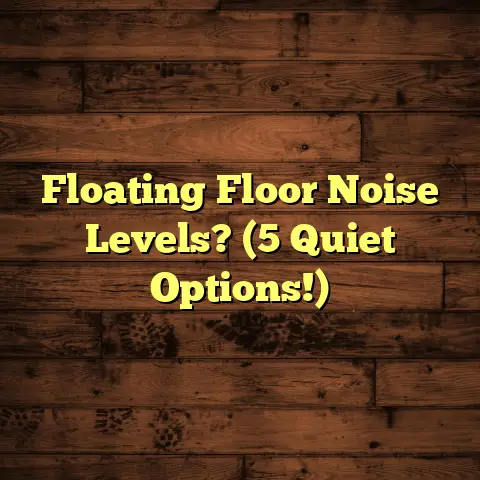Best Flood-Proof Floors? (3 May Surprise You!)
But guess what? The flooring industry has been busy innovating. We’re not stuck with just boring, utilitarian options anymore.
We now have stylish, durable, and truly flood-resistant floors that can stand up to the worst Mother Nature throws our way.
With climate change and urbanization increasing the frequency of flooding, investing in flood-resistant flooring is no longer just a good idea—it’s a necessity.
In this article, I’m going to walk you through the best flood-proof flooring options available today.
I’ll cover everything from tried-and-true materials to some surprising new technologies that might just blow your mind.
Ready to dive in? Let’s get started!
1. Understanding Flood-Proof Flooring
Okay, so what exactly is flood-proof flooring? It’s more than just water-resistant or waterproof. It’s flooring designed to withstand complete submersion without sustaining significant damage.
Think about it: water-resistant flooring might handle a spilled glass of water, while waterproof flooring can resist moisture from, say, a steamy bathroom.
Flood-proof flooring, on the other hand, needs to survive being completely underwater for extended periods.
Key Characteristics of Flood-Proof Flooring:
- Impermeability: The material itself doesn’t absorb water.
- Dimensional Stability: It doesn’t expand or contract significantly when wet.
- Mold and Mildew Resistance: It inhibits the growth of nasty organisms.
- Durability: It can withstand the force of floodwaters and debris.
Now, here’s a crucial point: even the best flood-proof flooring can fail if it’s not installed correctly.
Proper sealing, subfloor preparation, and drainage are essential for maximizing performance.
And don’t forget maintenance! Regular cleaning and inspections can help you catch potential problems before they turn into major disasters.
2. Innovative Flooring Materials
Let’s explore some of the most innovative flooring materials that offer excellent flood protection.
2.1. Vinyl Flooring
Vinyl flooring has come a long way since the linoleum days. Modern vinyl is incredibly durable, stylish, and, most importantly, waterproof.
Evolution of Vinyl Flooring:
Technological advancements have transformed vinyl flooring, making it more resistant to scratches, stains, and, of course, water damage.
Luxury vinyl tiles (LVT) and sheet vinyl are two popular options, and they both offer excellent flood protection.
- Luxury Vinyl Tiles (LVT): LVT mimics the look of natural stone or wood, but it’s much more resilient. It’s also easy to install, making it a great DIY option.
- Sheet Vinyl: Sheet vinyl comes in large rolls, minimizing seams and creating a virtually impenetrable barrier against water.
Benefits of Vinyl Flooring as a Flood-Proof Option:
- 100% Waterproof: Vinyl doesn’t absorb water, so it won’t swell, warp, or rot.
- Easy to Clean: Spills and messes wipe up easily.
- Durable: Vinyl can withstand heavy foot traffic and resist scratches and dents.
- Affordable: Vinyl is generally less expensive than other flood-proof options.
2.2. Tile Flooring
Ceramic and porcelain tiles have been a go-to choice for wet areas for decades, and for good reason.
These materials are naturally water-resistant, easy to clean, and incredibly durable.
Benefits of Tile Flooring:
- Inherent Water Resistance: Tile is virtually impervious to water, making it an excellent choice for flood-prone areas.
- Easy Maintenance: Tile is easy to clean and doesn’t require special treatments.
- Design Versatility: Tile comes in a wide range of colors, sizes, and styles, allowing for endless design possibilities.
Innovations in Tile Design:
We’re seeing some really cool innovations in tile design these days. From large-format tiles that minimize grout lines to textured tiles that provide extra grip, there’s a tile for every taste and need.
Here’s a table comparing the water absorption rates of different tile types, according to the Tile Council of North America (TCNA):
| Tile Type | Water Absorption Rate |
|---|---|
| Non-Vitreous | > 7.0% |
| Semi-Vitreous | 3.0% – 7.0% |
| Vitreous | 0.5% – 3.0% |
| Impervious (Porcelain) | < 0.5% |
As you can see, porcelain tiles are the most water-resistant, making them an ideal choice for flood-prone areas.
2.3. Engineered Wood
Engineered hardwood flooring might seem like an unlikely choice for flood-prone areas, but hear me out.
Unlike solid hardwood, engineered wood is constructed from multiple layers of wood veneer, which makes it more dimensionally stable and less likely to warp when exposed to moisture.
Construction of Engineered Wood:
The core layers of engineered wood are typically made from plywood or high-density fiberboard (HDF), which are more resistant to moisture than solid wood.
The top layer is a veneer of real hardwood, giving you the look and feel of solid wood without the same vulnerability to water damage.
Coatings and Finishes for Enhanced Water Resistance:
To further enhance water resistance, engineered wood floors can be treated with special coatings and finishes. These finishes create a protective barrier that repels water and prevents it from penetrating the wood.
I’ve seen some incredible results with these coatings, and they can make engineered wood a viable option for areas that are prone to occasional flooding.
2.4. Bamboo Flooring
Bamboo is a sustainable and durable flooring choice that’s naturally resistant to moisture. It’s also incredibly strong, thanks to its unique cellular structure.
Benefits of Bamboo Flooring:
- Sustainable: Bamboo is a rapidly renewable resource, making it an eco-friendly choice.
- Durable: Bamboo is harder than many hardwoods and can withstand heavy foot traffic.
- Moisture Resistant: Bamboo naturally resists moisture, making it a good choice for humid environments.
Strand-Woven Bamboo:
For even greater durability and moisture resistance, consider strand-woven bamboo. This type of bamboo is made by compressing bamboo fibers under high pressure, creating an incredibly dense and strong material.
Strand-woven bamboo is an excellent choice for high-humidity areas, such as basements and bathrooms.
3. Surprising Flood-Proof Flooring Options
Now, let’s get to the fun part! I’m going to share three surprising flood-proof flooring options that you might not have considered.
3.1. Rubber Flooring
Rubber flooring? I know what you’re thinking: “Isn’t that for gyms and playgrounds?”
Well, yes, but it’s also an incredibly versatile and flood-resistant flooring option.
Benefits of Rubber Flooring:
- Waterproof: Rubber is naturally waterproof and won’t absorb water.
- Slip-Resistant: Rubber provides excellent traction, even when wet.
- Easy to Clean: Rubber is easy to clean and doesn’t require special treatments.
- Durable: Rubber can withstand heavy foot traffic and resist dents and scratches.
Applications of Rubber Flooring:
Rubber flooring is a great choice for basements, garages, and even bathrooms. It’s also a popular option for commercial settings, such as gyms and hospitals.
I’ve seen some really creative uses of rubber flooring in residential settings, and it can add a unique and modern touch to any space.
3.2. Concrete Flooring
Polished concrete is another surprising flood-proof option that’s gaining popularity. Concrete is incredibly durable, and when properly sealed, it’s also water-resistant.
Benefits of Polished Concrete:
- Durable: Concrete can withstand heavy foot traffic and resist scratches and dents.
- Water-Resistant: When properly sealed, concrete is resistant to water damage.
- Modern Aesthetic: Polished concrete has a sleek and modern look that’s perfect for contemporary homes.
Finishes and Colors:
Polished concrete can be customized with a variety of finishes and colors to match any design style. You can choose from a matte, satin, or high-gloss finish, and you can add pigments to create a custom color.
I’ve seen some stunning concrete floors that look like marble or granite, and they’re incredibly durable and easy to maintain.
3.3. Smart Flooring Technologies
Okay, this is where things get really interesting. Smart flooring technologies are revolutionizing the way we think about flooring.
These systems incorporate sensors and other technologies to detect water leaks and respond accordingly.
How Smart Flooring Works:
Smart flooring systems use sensors to monitor moisture levels and temperature. If a leak is detected, the system can automatically shut off the water supply and alert the homeowner.
Some systems can even identify the location of the leak, making it easier to repair.
The Future of Flooring Technology:
The future of flooring technology is incredibly exciting. We’re seeing the development of sensors that can monitor air quality, detect falls, and even provide real-time feedback on your posture.
Imagine a floor that can tell you if you’re standing up straight or if you need to adjust your posture!
These technologies are still in their early stages, but they have the potential to transform the way we live and interact with our homes.
4. The Benefits of Choosing Flood-Proof Floors
So, why should you invest in flood-proof flooring? Let’s take a look at the benefits.
Financial Advantages:
- Reduced Repair Costs: Flood-proof flooring can save you thousands of dollars in repair costs after a flood.
- Increased Home Value: Flood-proof flooring can increase the value of your home, especially in flood-prone areas.
- Lower Insurance Premiums: Some insurance companies offer discounts for homes with flood-resistant features.
Comfort and Safety Benefits:
- Slip Resistance: Many flood-proof flooring options offer excellent slip resistance, even when wet.
- Lower Maintenance Requirements: Flood-proof flooring is typically easy to clean and maintain.
- Improved Air Quality: Some flood-proof flooring options are resistant to mold and mildew, which can improve indoor air quality.
Aesthetic Benefits:
- Stylish Designs: Flood-proof flooring is no longer limited to boring, utilitarian options. You can find stylish and attractive flooring that complements your home’s décor.
- Versatile Options: Flood-proof flooring is available in a wide range of colors, styles, and textures, allowing you to create a unique and personalized look.
- Increased Resale Value: Aesthetically pleasing flood-proof flooring can increase your home’s resale value, especially in areas where flooding is a concern.
5. Real-Life Applications and Success Stories
I’ve seen firsthand the difference that flood-proof flooring can make in people’s lives. Let me share a couple of stories with you.
Case Study 1: The Smith Family
The Smith family lived in a flood-prone area and had experienced several devastating floods. After the last flood, they decided to invest in flood-proof flooring.
They chose luxury vinyl tiles for their basement and ceramic tiles for their bathrooms. The results were amazing.
When the next flood hit, their new floors held up perfectly. They were able to clean up the mess quickly and easily, and they didn’t have to replace any flooring.
Case Study 2: The Johnson Business
The Johnson business was located in a commercial building that had a history of flooding. After a particularly bad flood, they decided to install rubber flooring throughout the building.
The rubber flooring not only protected the building from water damage but also provided a safer and more comfortable environment for their employees.
The Johnsons were so impressed with the results that they decided to install rubber flooring in their own home.
Conclusion
Choosing the right flooring for flood-prone areas is crucial for protecting your home and your investment.
Technological advancements have transformed the flooring industry, providing stylish yet functional choices that meet the demands of modern living in the face of climate challenges.
By investing in flood-proof flooring, you can enjoy peace of mind knowing that your home is protected from the devastating effects of water damage.
So, don’t wait until the next flood hits. Be proactive and explore the innovative options available today. Your home and your wallet will thank you for it!





